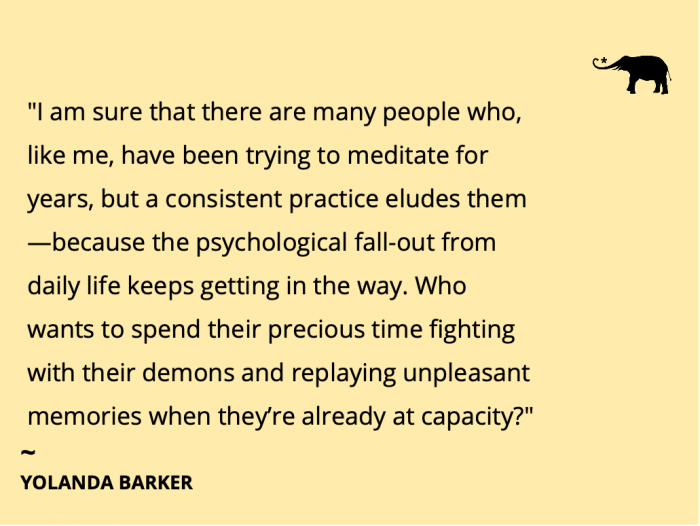Picture this:
You’re suffering from depression, and someone asks: “Have you tried meditation?”
Or, you broke up with your partner, lost your job, and your cat died. Your friend says: “You really need to meditate.”
Or this: you have chronic insomnia—you’ve spent nights in partial mania, staring into a black hellscape, and a doctor informs you that: “Meditation can really help.”
These scenarios aren’t hypothetical. They’ve all happened to me, and I bet everyone has experienced some version of them.
Meditation today has become the running of yesterday: a prescription for all mental, emotional, physical, and spiritual maladies. “Just do it,” people say—as though we’ve got a nut to crack, or a shoe lace to tie. “Join headspace!” “Go to a class!” “Do yoga!”
I mean, the suggestion isn’t wrong. Meditation is an amazing tool that gives us distance from our negative thoughts. It helps us develop awareness and compassion. Countless studies demonstrate that it boosts creativity, productivity, clarity, and well-being. I started in 2004 and it changed my life. I suffered with severe depression and anxiety, but meditation anchored me to the stillness inside myself. It stopped me from being swept away by the violent river of my mind.
Yeah, it’s great. But the real benefits of any practice come from consistency. Any artist or athlete will tell you that. You can’t, “Just do it.” You have to, “Do it,” over and over and over.
And the truth is, although the number of people practicing meditation has allegedly tripled since 2012 (it’s believed that between 200 and 500 million people now meditate), most people struggle to maintain a consistent practice.
I mean, let’s have a show of hands. How many of us meditate every day? And how many have sustained this practice for several years?
I hate to admit it, but my hand is down—even though I know how beneficial meditation is.
Back when I was a full-time yoga teacher, my spiritual practice was my main priority. I spent two hours every day practicing yoga, another hour meditating, and another hour doing breathing exercises. Every time I practiced, I anchored to something much bigger than me. I was in a good place.
Unfortunately, it was a luxury to have that kind of space for my mental health. It wasn’t sustainable. Eventually, my life came calling, and wanted me back. There were films to make, clients to please, and books to write. Although we’re still in the era of “living your best life,” where you’re expected to fit meditation, exercise, nutrition, success, popularity, family, and eight hours of sleep in to a 24 hour day—I couldn’t function in that Instagrammable reality.
In fact, my level of busyness is inversely proportional to my mental health. The more I’m doing, the more stressed I feel. The more stressed I am, the worse my anxiety and sleep are. The worse my mental health is, the more agonising it is to meditate.
Relatable?
I got to the point where my practice looked like this: sit down, close eyes, try to force mind to go blank, spend 10 minutes thinking about to-do lists, work, and a choice embarrassing memory. I was getting sucked in to the washing machine of my mind and meditating was actually make me more stressed. So, my practice became more sporadic—and then I felt guilty.
As a sensitive and easily triggered person, I knew I needed meditation. I felt like I was failing myself by not doing it. But shoehorning it in to my life wasn’t working. I was too emotionally dysregulated.
I am sure that there are many people who, like me, have been trying to meditate for years, but a consistent practice eludes them—because the psychological fall-out from daily life keeps getting in the way. It’s not the physical act of living though. I mean, everyone has 10 minutes to spare in a day. But who wants to spend their precious time fighting with their demons and replaying unpleasant memories when they’re already at capacity?
Once I understood why I was struggling to meditate, I stopped beating myself up about it. I saw that to even be able to sit for meditation, I needed to be calmer. I needed to find something that gave me the peace of meditation, but wasn’t as confronting. Something softer, more gentle.
And that’s when I realised—I could use my breath.
I don’t mean meditating by sitting and focusing on the breath. And I’m not talking about breathing exercises (which are amazing, and I’ve written about extensively in my book, The Breathing Revolution).
I could use breathing as a moving meditation.
Think about it: many forms of meditation use the breath as an anchor point—a tool to stop the mind from wandering. But, even if you don’t sit down to meditate, you’re still breathing. You breathe roughly 17,000 times during the waking hours. That’s 17,000 opportunities to bring your awareness to something other than your thoughts and 17,000 chances to become present with yourself.
To begin, I would simply bring my awareness to my breath whenever I thought of it, and then lengthen my exhale fore three cycles of breath. No matter where I was or what I was doing, this tiny habit (lasting approximately 15 seconds) would centre, focus, and ground me. It gave me a little meditation hit.
Simply lengthening our exhale slows our heart rate down and shifts our nervous system from a state of activity (fight or flight), to a place of relaxation (rest and digest). This reduces mental activity and the mind becomes more still.
Over time, I increased the amount of breaths I took. Every time I thought of my breathing, I would breathe consciously until I got distracted again. Whenever I remembered my breathing again, I’d go back to lengthening my exhale.
This isn’t a novel idea—there are even apps around that remind you to breathe on an hourly basis, but with time, I noticed that I was spending longer and longer in a state of moving meditation. I’d walk to the underground whilst focused on my breath. I’d get the train, focused on my breath. I’d walk through the city and be focused on my breath. I’d work at my computer, breathing slowly.
Gradually, I felt my nervous system regulate. I felt calmer in the face of stress—closer to how it felt at the time when I was teaching yoga. And at that point, I started being able to sit for meditation again.
Although I’m still not back in a daily meditation practice, I’ve noticed that harnessing my breath helps me ride out all kinds of situations. I’m more grounded, present, and aware. I’m more in-tune with what’s going on with me, which helps me hold space for my emotions, and have better boundaries with others. In other words, I’m noticing big benefits for my mental health.
There’s probably no real substitute for seated meditation. It’s uniquely beneficial. But breathing consciously can give us maximum anchorage with the least effort. It makes us flexible. It’s accessible. It can be approached from a completely scientific, irreligious perspective.
And, we don’t even need to force ourselves to do it—we’re already breathing.









Read 8 comments and reply